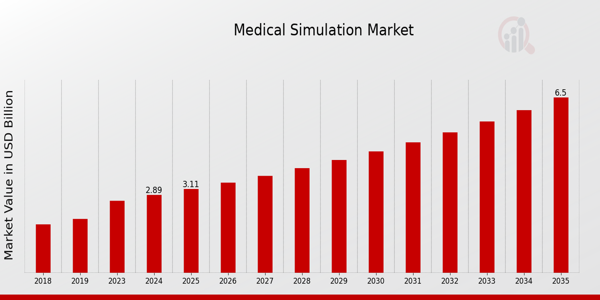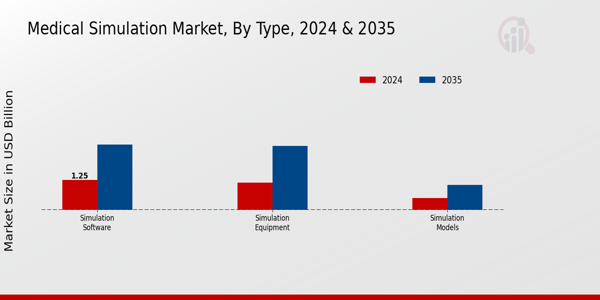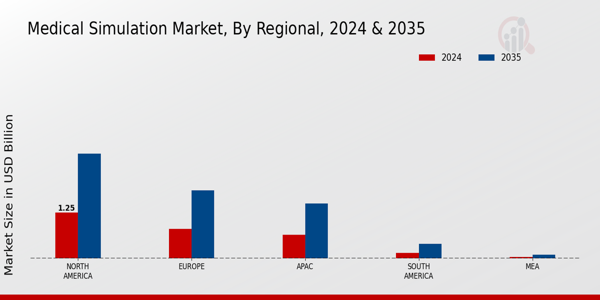Medical Simulation Market Overview
As per MRFR analysis, the Medical Simulation Market Size was estimated at 2.68 (USD Billion) in 2023.The Medical Simulation Market Industry is expected to grow from 2.89(USD Billion) in 2024 to 6.5 (USD Billion) by 2035. The Medical Simulation Market CAGR (growth rate) is expected to be around 7.64% during the forecast period (2025 - 2035)
Key Medical Simulation Market Trends Highlighted
Driven by technological developments and the growing need for efficient healthcare training solutions, the Global Medical Simulation Market is showing many noteworthy trends. Key market drivers include the growing focus on patient safety, which has increased the need for simulation-based training among healthcare workers. Investing in simulation technology has become absolutely vital for guaranteeing high standards of treatment as healthcare systems all over the globe give the lowering of medical mistakes top priority. The training experience is also being improved by the continuous development of digital technologies such as augmented reality and virtual reality, hence increasing the immersion and efficacy of medical simulations.
Opportunities to be investigated in the Global Medical Simulation Market include increasing access to various training options in underdeveloped areas. Partnerships between educational institutions and healthcare organizations may help close holes in training infrastructure. Moreover, the inclusion of mobile medical simulation systems lets healthcare workers train in many environments and reach a larger audience. By meeting the rising need for ongoing medical education, this adaptability may greatly improve learning results and boost user involvement. Recent trends indicate a clear rise in the use of high-fidelity simulators.
These simulators provide safe, realistic situations for healthcare professionals to train and hone their abilities. The worldwide move toward digital solutions aggravated by the COVID-19 pandemic has driven demand for online simulation-based learning as well, hence promoting creative ideas to medical education. Driven by technology developments and a strong dedication to enhancing healthcare training and patient safety, the Global Medical Simulation Market is generally set for continuous expansion.

Source: Primary Research, Secondary Research, MRFR Database and Analyst Review
Medical Simulation Market Drivers
Increasing Demand for Medical Training and Education
Driven by the need for healthcare workers to get improved training without the hazards connected with conventional approaches, the Global Medical Simulation Market Industry is seeing a notable rise in demand for medical training and education. As the World Health Organization claims, a major worldwide issue is the expected lack of 18 million health professionals by 2030. To guarantee a well-prepared workforce, nations are spending more on medical education.
For example, the Collaborating Centre for Evidence-Based Practice has started initiatives to improve simulation-based learning among medical professionals in several parts of the world, including Europe and North America. Educational institutions need creative simulation technologies to teach future healthcare professionals properly, so this focus on medical education helps to grow the Global Medical Simulation Market.
Technological Advancements in Medical Simulation
Rapid developments in simulation technologies, including virtual reality (VR) and augmented reality (AR), are propelling expansion in the Global Medical Simulation Market. Leading the way have been businesses like CAE Healthcare and Laerdal Medical, which are creating innovative simulation tools to improve the learning environment for healthcare professionals. Industry trends indicate that more than half of medical education programs globally now use simulation technologies.
This tendency points to an increasing awareness of the efficacy of simulation in enhancing clinical skills and patient safety. The use of this cutting-edge technology not only improves realism but also allows students to simulate situations that would be challenging or unattainable in real life, hence driving market expansion.
Growing Preference for Patient Safety and Quality Care
A driving force for the Global Medical Simulation Market Industry, there is a clear trend toward enhancing patient safety and quality of treatment. The Institute of Medicine estimates that in healthcare environments, medical mistakes cause a notable yearly mortality toll. Healthcare institutions all over are thus spending money on simulation-based training to lower errors and enhance therapeutic results. Organizations such as the Joint Commission have also underlined the need for simulation training in shaping clinical skills matching patient safety goals.
The need for medical simulation tools is predicted to increase considerably with continuous legislative activity and increased awareness of the need for safer healthcare practices, hence supporting market expansion.
Medical Simulation Market Segment Insights
Medical Simulation Market Type Insights
The Global Medical Simulation Market is characterized by its diverse Type segmentation, particularly focusing on Simulation Software, Simulation Equipment, and Simulation Models. In 2024, the overall market is projected to reach a valuation of 2.89 USD Billion, with significant contributions coming from these three categories. Simulation Software is expected to hold a majority with a valuation of 1.25 USD Billion, showing its vital role in enhancing the learning experience through interactive and scenario-based training modules. By 2035, this subsegment is anticipated to grow to 2.75 USD Billion, reflecting the increasing adoption of digital solutions in medical training that improve competence and performance among healthcare professionals.
Following closely, Simulation Equipment is valued at 1.15 USD Billion in 2024 and is expected to reach 2.7 USD Billion by 2035, signifying its essential function in providing hands-on training through realistic simulations of medical scenarios and procedures. This equipment encompasses advanced tools, such as mannequins and simulation environments that allow for immersive training experiences. While Simulation Models are forecasted to grow from a valuation of 0.49 USD Billion in 2024 to 1.05 USD Billion in 2035, they represent a niche yet significant part of the market, focusing on the development of anatomical and physiological models that assist in visualizing complex medical conditions in educational settings.The growth in the Global Medical Simulation Market is driven by the rising need for effective training approaches in the healthcare sector and the push towards improved patient safety and outcomes.
Moreover, global trends emphasize the incorporation of technology in healthcare education, with increased investment in medical training programs as a primary opportunity in this evolving landscape. However, challenges such as the high costs of advanced simulation systems may pose certain limitations to market expansion. Overall, the Global Medical Simulation Market segmentation reveals critical insights into how each segment contributes to improving the efficiency and efficacy of medical training, leading to better-prepared healthcare professionals worldwide.

Source: Primary Research, Secondary Research, MRFR Database and Analyst Review
Medical Simulation Market Application Insights
The Global Medical Simulation Market segment focusing on Applications is witnessing significant growth, with the overall market expected to be valued at 2.89 USD Billion in 2024, growing to 6.5 USD Billion by 2035. The Global Medical Simulation Market revenue is largely influenced by advancements in technology and the demand for safer medical practices. Among the various applications, Surgical Simulation is crucial as it allows medical professionals to practice complex procedures in a risk-free environment, enhancing surgical skills and patient safety.Patient Simulation continues to gain traction as it creates realistic scenarios that help healthcare providers improve their diagnostic and patient care skills.
Additionally, Procedural Simulation plays a vital role in providing hands-on experience for healthcare specialists, allowing them to refine their techniques. Virtual Reality Simulation is also emerging as a dominant application, offering immersive training experiences that mimic real-life scenarios, resulting in better retention of skills and knowledge. Overall, the Global Medical Simulation Market segmentation showcases a robust landscape essential for the continuous development of healthcare professionals across the globe, aiming to improve patient outcomes and streamline medical education.
Medical Simulation Market End Use Insights
The Global Medical Simulation Market, with a projected value of 2.89 USD Billion in 2024, reflects significant growth driven by a myriad of stakeholders in the healthcare sector. Among the End Use segments, Hospitals play a crucial role due to the increasing emphasis on advanced training methods that enhance clinical skills and patient safety. Academic Institutions are vital contributors, integrating simulation-based education into curricula to better prepare future healthcare professionals. Military Organizations also value medical simulations for training purposes, ensuring that personnel can respond effectively in high-pressure environments.Additionally, Healthcare Providers leverage simulation technologies to improve patient outcomes and provide thorough staff training, adapting their methods to meet real-world challenges.
As the Global Medical Simulation Market segmentation indicates, these areas continue to dominate the market landscape, driven by a continuous need for improved training and education in various medical fields. The growth in these segments highlights the importance of effective simulation techniques that address both practical and theoretical aspects of medical care.The overall trend reflects an increasing investment in technologies that enhance learning and preparedness within the global healthcare system.
Medical Simulation Market Technology Insights
The Global Medical Simulation Market revenue is poised for significant growth as it reaches an estimated value of 2.89 USD Billion in 2024, with projections pointing towards 6.5 USD Billion by 2035. The Technology segment plays a pivotal role in shaping this market, driven by advancements in High-Fidelity Simulation systems, which offer realistic training opportunities, greatly enhancing the learning experience for medical professionals. Meanwhile, Low-Fidelity Simulation continues to provide essential foundational training at a lower cost, making it a vital component in educational settings.Virtual Simulation has also emerged as a prevalent method, leveraging technology to create immersive learning environments that are increasingly vital in the current healthcare landscape.
Collectively, these technologies cater to the diverse needs of the healthcare industry, facilitating skill acquisition and improving patient outcomes. The integration of these innovative technologies represents a notable trend, as they address the growing demand for effective training solutions while overcoming challenges such as limited access to real-world clinical scenarios.The Global Medical Simulation Market segmentation demonstrates a significant shift towards these advanced training methodologies, underlining their importance in the future of medical education and training.
Medical Simulation Market Regional Insights
The Global Medical Simulation Market displays significant regional diversity, with North America demonstrating a majority holding, valued at 1.25 USD Billion in 2024, and expected to grow to 2.85 USD Billion by 2035. This region is pivotal due to advanced healthcare infrastructure and substantial investment in Research and Development initiatives. Europe follows with a valuation of 0.8 USD Billion in 2024, likely reaching 1.85 USD Billion by 2035, driven by increasing adoption of simulation-based training among medical professionals to enhance patient safety.
The Asia-Pacific (APAC) region is also gaining traction, with a market value of 0.65 USD Billion in 2024, projected to grow to 1.5 USD Billion by 2035, reflecting a growing emphasis on improving medical education standards across developing countries. South America and the Middle East and Africa (MEA) represent smaller yet emerging markets, valued at 0.15 USD Billion and 0.04 USD Billion in 2024, respectively, with opportunities for growth as healthcare systems evolve and demand for innovative training solutions increases. Overall, the Global Medical Simulation Market demonstrates robust potential across regions, driven by the increasing need for effective training methodologies in the healthcare industry.

Source: Primary Research, Secondary Research, MRFR Database and Analyst Review
Medical Simulation Market Key Players and Competitive Insights
The Global Medical Simulation Market is characterized by a competitive landscape that is rapidly evolving, driven by technological advancements and increasing demand for effective training solutions in healthcare. As medical education continues to progress, companies in this market are focusing on innovation and enhanced user experiences to appeal to educational institutions, hospitals, and healthcare professionals. The competition is heightened by a variety of players, each offering unique simulation products ranging from high-fidelity mannequins to virtual reality training modules. Market dynamics are influenced by increasing investments in healthcare infrastructure, growing awareness about the importance of medical training, and shifts towards hands-on learning methodologies.
These factors contribute to the competitive nature of the market, where companies are vying for market share and striving to provide cutting-edge solutions that meet the evolving needs of the healthcare sector.Gaumard Scientific has established a strong presence in the Global Medical Simulation Market with its innovative range of advanced simulation products designed to improve medical training and education. The company is renowned for its high-fidelity simulators that allow for realistic training scenarios, catering to various healthcare specialties. Gaumard Scientific leverages its robust research and development capabilities to consistently introduce new products, maintaining a competitive edge. The company's commitment to quality and its reputation for producing reliable and effective simulation solutions further solidify its position in the market.
With a global footprint, Gaumard is well-recognized for its comprehensive training solutions, enhancing its appeal to educational institutions and healthcare organizations worldwide.Zimmer Biomet, a key player in the Global Medical Simulation Market, is known for its innovative products and a wide range of surgical simulation and training solutions. The company emphasizes developing training tools that align with the demands of healthcare professionals by offering simulated surgical environments and training modules. Through strategic mergers and acquisitions, Zimmer Biomet has expanded its market presence, allowing for greater distribution and an enhanced portfolio of medical simulation offerings.
Its strengths lie in its established relationships with healthcare providers and educational institutions, fostering collaboration and user feedback to improve products continually. By focusing on technological advancements and customer-centric solutions, Zimmer Biomet reinforces its position as a leader in the medical simulation space on a global scale, ensuring that healthcare professionals are well-prepared for real-world challenges.
Key Companies in the Medical Simulation Market Include
- Gaumard Scientific
- Zimmer Biomet
- Kdis
- Simbionix
- Respironics
- CAE Healthcare
- Laerdal Medical
- 3D Systems
- Surgical Science
- Simulaids
- Training for Warriors
- MockingBird
- Medtronic
- Virtual Medical Coaching
- Boston Scientific
Medical Simulation Market Industry Developments
The Global Medical Simulation Market has been witnessing significant advancements and growth recently. A notable development is the increasing collaboration between companies such as CAE Healthcare and Laerdal Medical, aimed at enhancing their simulation training solutions to meet rising demands for healthcare provider educational needs. In October 2023, Gaumard Scientific launched an advanced patient simulator that is expected to improve surgical training and teaching methodologies. Furthermore, in September 2023, Simbionix announced the expansion of its product offerings to include virtual reality solutions specifically tailored for surgical training, reflecting ongoing trends towards immersive technologies.
The market has been bolstered by a surge in demand for innovative simulation tools, with Zimmer Biomet and Medtronic investing heavily in Research and Development to refine simulation platforms. Merger and acquisition activity has also become prominent, with MockingBird acquiring smaller simulation technology firms in August 2023 to broaden its portfolio. In terms of market valuation, organizations have reported significant revenue growth driven by increased adoption across educational institutions and healthcare facilities globally, indicating a strong upward trend in the sector, particularly over the last two years.
Medical Simulation Market Segmentation Insights
- Medical Simulation Market Type Outlook
- Simulation Software
- Simulation Equipment
- Simulation Models
- Medical Simulation Market Application Outlook
- Surgical Simulation
- Patient Simulation
- Procedural Simulation
- Virtual Reality Simulation
- Medical Simulation Market End Use Outlook
- Hospitals
- Academic Institutions
- Military Organizations
- Healthcare Providers
- Medical Simulation Market Technology Outlook
- High-Fidelity Simulation
- Low-Fidelity Simulation
- Virtual Simulation
- Medical Simulation Market Regional Outlook
- North America
- Europe
- South America
- Asia Pacific
- Middle East and Africa
| Report Attribute/Metric Source: |
Details |
| MARKET SIZE 2023 |
2.68(USD Billion) |
| MARKET SIZE 2024 |
2.89(USD Billion) |
| MARKET SIZE 2035 |
6.5(USD Billion) |
| COMPOUND ANNUAL GROWTH RATE (CAGR) |
7.64% (2025 - 2035) |
| REPORT COVERAGE |
Revenue Forecast, Competitive Landscape, Growth Factors, and Trends |
| BASE YEAR |
2024 |
| MARKET FORECAST PERIOD |
2025 - 2035 |
| HISTORICAL DATA |
2019 - 2024 |
| MARKET FORECAST UNITS |
USD Billion |
| KEY COMPANIES PROFILED |
Gaumard Scientific, Zimmer Biomet, Kdis, Simbionix, Respironics, CAE Healthcare, Laerdal Medical, 3D Systems, Surgical Science, Simulaids, Training for Warriors, MockingBird, Medtronic, Virtual Medical Coaching, Boston Scientific |
| SEGMENTS COVERED |
Type, Application, End Use, Technology, Regional |
| KEY MARKET OPPORTUNITIES |
Advancements in VR technology, Increasing demand for remote training, Growth in healthcare spending, Rising focus on patient safety, Expanding use of simulation in medical education |
| KEY MARKET DYNAMICS |
rising healthcare expenditures, technological advancements, increasing demand for skilled professionals, emphasis on patient safety, expansion of healthcare infrastructure |
| COUNTRIES COVERED |
North America, Europe, APAC, South America, MEA |
Medical Simulation Market Highlights:
Frequently Asked Questions (FAQ) :
The Global Medical Simulation Market is expected to be valued at 2.89 USD Billion in 2024.
By 2035, the market is projected to be valued at 6.5 USD Billion.
The expected CAGR for the Global Medical Simulation Market from 2025 to 2035 is 7.64%.
North America is anticipated to dominate the market, reaching a value of 2.85 USD Billion by 2035.
Simulation Software is valued at 1.25 USD Billion in the Global Medical Simulation Market for the year 2024.
The market for Simulation Equipment is expected to reach 2.7 USD Billion by 2035.
The market for Simulation Models is projected to be valued at 0.49 USD Billion in 2024.
Major players include Gaumard Scientific, Zimmer Biomet, CAE Healthcare, and Laerdal Medical among others.
The APAC region is likely to experience significant growth, with a market size expected to reach 1.5 USD Billion by 2035.
The market size for South America is projected to reach 0.4 USD Billion by 2035.

















